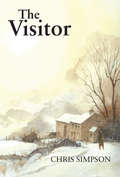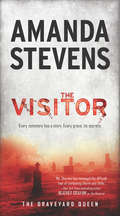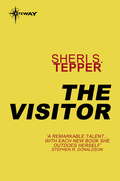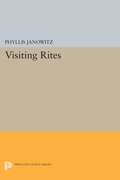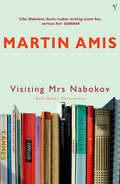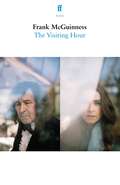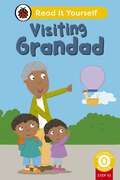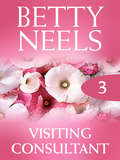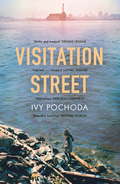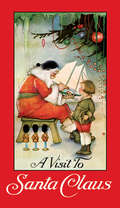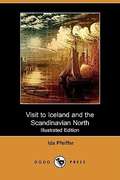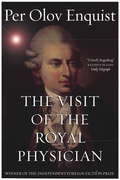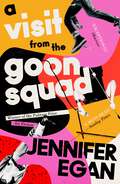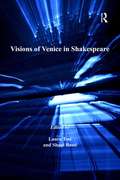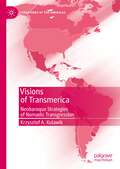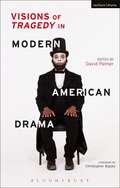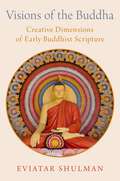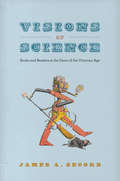- Table View
- List View
The Visitor: A Christmas Story from the Yorkshire Dales
by Chris SimpsonEach line of this beautifully crafted Christmas story evokes the rugged countryside that the author loves, the heartlands of the Yorkshire Dales. A moving and charming story to warm our hearts at Christmas time. *** Jos Robertshaw and his wife, Emily, are Yorkshire hill farmers, used to being self-sufficient in a hard and sometimes bleak landscape. On a cold and snowy night when they open the door of their self-contained world to a mysterious visitor nothing will ever be quite the same again.
The Visitor (The Graveyard Queen #5)
by Amanda StevensI am a living ghost, a wanderer in search of my purpose and place…
The Visitor (Gollancz S. F. Ser.)
by Sheri S. TepperSheri Tepper, one of the foremost science fiction writers in the world, gives us an exciting, evocative and thought-provoking tale where science and magic meet head-on. A group of colonists, waking every few hundred years to see what's been happening on the planet they fled to from a dying Earth, watch as the systems and rules they set in place so long ago become debased and decayed. The corrupt leaders govern by oppression, but technological resources run low and the knowledge of how to replace them is lost in the mists of time. Instead, the power-hungry leaders turn to sorcery of the blackest kind, kindled by pain and despair. And when they launch a religious crusade to wipe out all those who won't conform to the government's ever-more-stringent dictates, not even the original colonists - the new gods - are safe from the ravaging sorcery-fuelled armies of the righteous . . .
Visiting Rites
by Phyllis JanowitzThe description for this book, Visiting Rites, will be forthcoming.Originally published in 1982.The Princeton Legacy Library uses the latest print-on-demand technology to again make available previously out-of-print books from the distinguished backlist of Princeton University Press. These editions preserve the original texts of these important books while presenting them in durable paperback and hardcover editions. The goal of the Princeton Legacy Library is to vastly increase access to the rich scholarly heritage found in the thousands of books published by Princeton University Press since its founding in 1905.
Visiting Mrs Nabokov And Other Excursions (Vintage International Series)
by Martin AmisFuelled by innumerable cigarettes, Martin Amis provides dazzling portraits of contemporaries and mentors alike: Larkin and Rushdie; Greene and Pritchett; Ballard and Burgess and Nicholson Baker; John Updike - warts and all. Vigorously zipping across to Washington, he exposes the double-think of nuke-speak; in New Orleans the Republican Convention gets a going over. And then there's sport: he visits the world of darts and its disastrous attempt to clean itself up; dirty tricks in the world of chess; and some brisk but vicious poker with Al Alvarez and David Mamet. Sex without Madonna, expulsion from school, a Stones gig that should have been gagged, on set with Robocop or on court with Gabriela Sabatini, this is Martin Amis at his electric best.
The Visiting Hour
by Frank McGuinnessYou used to swing me on our garden gate. In and out, in and out - out and in, me, on top of the gate, safe because I was in your arms, my father's big strong arms.Recalling events that may or may not have happened, people he may or may not have known, an elderly father weaves his life, funny, angry, poignant, as if in a dream.His daughter, perched outside his window, as close as the pandemic allows, responds with conflicting memories. They sing and argue, they broach dangerous ground, their profound love apparent despite themselves, until the visiting hour is up.Written during the Covid-19 lockdown of 2020, Frank McGuinness's The Visiting Hour premiered in April 2021 at the Gate Theatre, Dublin, in the first online Gate At Home production.
Visiting Grandad (Read It Yourself)
by LadybirdTwo stories that build on the phonics learned in previous steps and practise sound and letter combinations that have already been encountered.Visiting Grandad is from Beginner Reader Level 0 and is ideal for children aged from 4+ who are developing their phonics and early reading skills.Each book has been carefully checked by educational and subject consultants and includes comprehension puzzles, book band information, and tips for helping children with their reading.With five levels to take children from first phonics to fluent reading and a wide range of different stories and topics for every interest, Read It Yourself helps children build their confidence and begin reading for pleasure.
Visiting Consultant (Betty Neels Collection #3)
by Betty NeelsMills & Boon presents the complete Betty Neels collection. Timeless tales of heart-warming romance by one of the world’s best-loved romance authors.
Visitation Street: A Novel
by Ivy PochodaSummer in Red Hook, Brooklyn, a blue collar neighbourhood where hipster gourmet supermarkets push against tired housing projects, and the East River opens into the bay. Bored and listless, fifteen-year-old June and Val are looking for some fun. Forget the boys, the bottles, the coded whistles. Val wants to do something wild and a little crazy: take a raft out onto the bay.But out on the water, as the bright light of day gives way to darkness, the girls disappear. Only Val will survive, washed ashore semi-conscious in the weeds.June's shocking disappearance will reverberate in the lives of a diverse cast of Red Hook residents. Fadi, the Lebanese bodega owner, trolls for information about the crime. Cree, just beginning to pull it together after his father's murder, unwittingly makes himself the chief suspect - although an elusive guardian seems to have other plans for him. As Val emerges from the shadow of her missing friend, her teacher Jonathan, Juilliard drop-out and barfly, will be forced to confront a past riddled with tragic sins of omission.In VISITATION STREET, Ivy Pochoda combines intensely vivid prose with breathtaking psychological insight to explore a cast of solitary souls, pulled by family, love, and betrayal, who yearn for a chance to escape, no matter the cost.
A Visit to Santa Claus
by Margaret Evans PriceCharming light verse and fourteen graceful illustrations tell the story of an "everyday boy" named Teddy Malleen who travels to the North Pole in a flying machine, where he meets Santa and explores the legendary toy shop.Originally published in 1916, this holiday treasure has been reproduced in a large, sturdy format that's perfect for little hands and will last for many seasons. A lovely gift book and a fun adventure for kids, it's a must-have edition for collectors of antique children's books and vintage Christmas memorabilia
Visit to Iceland and the Scandinavian North
by Ida PfeifferA besetting sin of the Icelanders is their drunkenness. Their poverty would probably not be so great if they were less devoted to brandy, and worked more industriously. <P> <P> It is dreadful to see what deep root this vice has taken. Not only on Sundays, but also on week-days, I met peasants who were so intoxicated that I was surprised how they could keep in their saddle. I am, however, happy to say that I never saw a woman in this degrading condition.
The Visit of the Royal Physician
by Per Olov EnquistAdultery, insanity, back-stabbing and blue blood in 18th century Denmark . . . The winner of THE INDEPENDENT FOREIGN FICTION PRIZE, Sweden's AUGUST PRIZE and France's Best Foreign Book AwardIt is the 1760s, the height of the Enlightenment, a time of great promise and transformation across Europe, but in the state of Denmark something is rotten. The young king, Christian VII, is a half-wit. His queen, the English princess Caroline Mathilde, has fallen in love his most trusted advisor, the court physician, Struensee, who is engaged in a bitter ideological battle with the head of the diplomatic corps, Guldberg. Gulberg, a cold-blooded religious fanatic, is determined too annihilate the Enlightenment ideals - which threaten to improve the lot of the peasantry and to support freedom of the press - that Struensee is introducing to Denmark. Whoever prevails will not only control the king but the nation state. The victor will impress his legacy on the kingdom: either Struensee's free-thinking principles or the repressive proscriptions of Guldberg.Enquist's masterpiece, acclaimed throughout Europe, is a superb examination of the clash between the raptures of love and the certainties of dogma, the torments of the flesh and the enticements of power. It is an unforgettable introduction to a fascinating period in European history.
A Visit From the Goon Squad
by Jennifer EganJennifer Egan's spellbinding novel circles the lives of Bennie Salazar, an ageing former punk rocker and record executive, and Sasha, the passionate, troubled young woman he employs. Although Bennie and Sasha never discover each other's pasts, the reader does, in intimate detail, along with the secret lives of a host of other characters whose paths intersect with theirs, over many years, in locales as varied as New York, San Francisco, Naples, and Africa.We first meet Sasha in her mid-thirties, on her therapist's couch in New York City, confronting her long-standing compulsion to steal. Later, we learn the genesis of her turmoil when we see her as the child of a violent marriage, then a runaway living in Naples, then as a college student trying to avert the suicidal impulses of her best friend. We meet Bennie Salazar at the melancholy nadir of his adult life-divorced, struggling to connect with his nine-year-old son, listening to a washed up band in the basement of a suburban house-and then revisit him in 1979, at the height of his youth, shy and tender, revelling in San Francisco's punk scene as he discovers his ardour for rock and roll and his gift for spotting talent. We learn what became of his high school gang-who thrived and who faltered-and we encounter Lou Kline, Bennie's catastrophically careless mentor, along with the lovers and children left behind in the wake of Lou's far flung sexual conquests and meteoric rise and fall.A Visit from the Goon Squad is a book about the interplay of time and music, about survival, about the stirrings and transformations set inexorably in motion by even the most passing conjunction of our fates. In a breathtaking array of styles and tones ranging from tragedy to satire to Powerpoint, Egan captures the undertow of self-destruction that we all must either master or succumb to; the basic human hunger for redemption; and the universal tendency to reach for both-and escape the merciless progress of time-in the transporting realms of art and music. Sly, startling, exhilarating work from one of our boldest writers.
A Visit From St Nicholas and Other Merry Tales
by Maxine BarryThis collection of illustrated Christmas stories is perfect for reading together. Whether you are looking for familiar classics or new discoveries, these tales will charm and delight children of all ages.Help improve your child's reading in just 10 minutes a day with Storytime.10 minutes of reading a day can...Boost VocabularyReading for a short period every day exposes your child to almost 1 million words per year, which helps to foster communication and understanding.Encourage LearningReading at home is linked to better performance in spelling, comprehension and general knowledge, helping to develop important learning skills.Promote RelaxationReading a book gives your child the quiet time they need each day to relax, and is a great way for you to spend quality time together.
Visions of Venice in Shakespeare (Anglo-Italian Renaissance Studies)
by Laura Tosi Shaul BassiDespite the growing critical relevance of Shakespeare's two Venetian plays and a burgeoning bibliography on both The Merchant of Venice and Othello, few books have dealt extensively with the relationship between Shakespeare and Venice. Setting out to offer new perspectives to a traditional topic, this timely collection fills a gap in the literature, addressing the new historical, political and economic questions that have been raised in the last few years. The essays in this volume consider Venice a real as well as symbolic landscape that needs to be explored in its multiple resonances, both in Shakespeare's historical context and in the later tradition of reconfiguring one of the most represented cities in Western culture. Shylock and Othello are there to remind us of the dark sides of the myth of Venice, and of the inescapable fact that the issues raised in the Venetian plays are tremendously topical; we are still haunted by these theatrical casualties of early modern multiculturalism.
Visions of Venice in Shakespeare (Anglo-Italian Renaissance Studies)
by Laura Tosi Shaul BassiDespite the growing critical relevance of Shakespeare's two Venetian plays and a burgeoning bibliography on both The Merchant of Venice and Othello, few books have dealt extensively with the relationship between Shakespeare and Venice. Setting out to offer new perspectives to a traditional topic, this timely collection fills a gap in the literature, addressing the new historical, political and economic questions that have been raised in the last few years. The essays in this volume consider Venice a real as well as symbolic landscape that needs to be explored in its multiple resonances, both in Shakespeare's historical context and in the later tradition of reconfiguring one of the most represented cities in Western culture. Shylock and Othello are there to remind us of the dark sides of the myth of Venice, and of the inescapable fact that the issues raised in the Venetian plays are tremendously topical; we are still haunted by these theatrical casualties of early modern multiculturalism.
Visions of Transmerica: Neobaroque Strategies of Nomadic Transgression (Literatures of the Americas)
by Krzysztof A. KulawikThis book looks at Neobaroque Latin American fiction, poetry, essay and performance from the 1970s to the early 2000s in order to explore the cultural hybridization and transgressive identity transformations at play in these works. It shows how the ornamental style and boldly experimental techniques are an effective strategy in presenting decentered identities in sexually ambiguous, multiethnic, interracial, transcultural, and mutant characters, as well as in metafictional narrators and authors. In this way, the book demonstrates the potential of Neobaroque works to destabilize normative, essentialist and binary categories of identity. The study focuses on Latin America as a cultural macroregion, drawing on examples from a variety of countries, including Argentina, Uruguay, Chile, Bolivia, Brazil, Cuba, Mexico, and the US-Mexican border. Drawing on gender, queer, trans and Chicana feminist theory, it argues for an alternative approach to a model of the Self, or a theory of selfhood, derived from the exuberant style and experimental techniques of the Neobaroque.
Visions of Tragedy in Modern American Drama
by David PalmerThis volume responds to a renewed focus on tragedy in theatre and literary studies to explore conceptions of tragedy in the dramatic work of seventeen canonical American playwrights. For students of American literature and theatre studies, the assembled essays offer a clear framework for exploring the work of many of the most studied and performed playwrights of the modern era. Following a contextual introduction that offers a survey of conceptions of tragedy, scholars examine the dramatic work of major playwrights in chronological succession, beginning with Eugene O'Neill and ending with Suzan-Lori Parks. A final chapter provides a study of American drama since 1990 and its ongoing engagement with concepts of tragedy.The chapters explore whether there is a distinctively American vision of tragedy developed in the major works of canonical American dramatists and how this may be seen to evolve over the course of the twentieth century through to the present day. Among the playwrights whose work is examined are: Susan Glaspell, Langston Hughes, Tennessee Williams, Arthur Miller, Edward Albee, Lorraine Hansberry, Amiri Baraka, August Wilson, Marsha Norman and Tony Kushner. With each chapter being short enough to be assigned for weekly classes in survey courses, the volume will help to facilitate critical engagement with the dramatic work and offer readers the tools to further their independent study of this enduring theme of dramatic literature.
Visions of Tragedy in Modern American Drama
by David PalmerThis volume responds to a renewed focus on tragedy in theatre and literary studies to explore conceptions of tragedy in the dramatic work of seventeen canonical American playwrights. For students of American literature and theatre studies, the assembled essays offer a clear framework for exploring the work of many of the most studied and performed playwrights of the modern era. Following a contextual introduction that offers a survey of conceptions of tragedy, scholars examine the dramatic work of major playwrights in chronological succession, beginning with Eugene O'Neill and ending with Suzan-Lori Parks. A final chapter provides a study of American drama since 1990 and its ongoing engagement with concepts of tragedy.The chapters explore whether there is a distinctively American vision of tragedy developed in the major works of canonical American dramatists and how this may be seen to evolve over the course of the twentieth century through to the present day. Among the playwrights whose work is examined are: Susan Glaspell, Langston Hughes, Tennessee Williams, Arthur Miller, Edward Albee, Lorraine Hansberry, Amiri Baraka, August Wilson, Marsha Norman and Tony Kushner. With each chapter being short enough to be assigned for weekly classes in survey courses, the volume will help to facilitate critical engagement with the dramatic work and offer readers the tools to further their independent study of this enduring theme of dramatic literature.
Visions of the Buddha: Creative Dimensions of Early Buddhist Scripture
by Eviatar ShulmanVisions of the Buddha offers a ground-breaking approach to the nature of the early discourses of the Buddha, the most foundational scriptures of Buddhist religion. Although the early discourses are commonly considered to be attempts to preserve the Buddha's teachings, Shulman demonstrates that these texts are full of creativity, and that their main aim is to beautify the image of the wonderous Buddha. While the texts surely care for the early teachings and for the Buddha's philosophy or his guidelines for meditation, and while at times they may relate real historical events, they are no less interested in telling good stories, in re-working folkloric materials, and in the visionary contemplation of the Buddha in order to sense his unique presence. The texts can thus be, at times, a type of meditation. Eviatar Shulman frames the early discourses as literary masterpieces that helped Buddhism achieve the wonderful success it has obtained. Much of the discourses' masterful storytelling was achieved through a technique of composition defined here as the play of formulas. In the oral literature of early Buddhism, texts were composed of formulas, which are repeated within and between texts. Shulman argues that the formulas are the real texts of Buddhism, and are primary to full discourses. Shaping texts through the play of formulas balances conservative and innovative tendencies within the tradition, making room for creativity within accepted forms and patterns. The texts we find today are thus versions--remnants--chosen by history of a much more vibrant and dynamic creative process.
Visions of the Buddha: Creative Dimensions of Early Buddhist Scripture
by Eviatar ShulmanVisions of the Buddha offers a ground-breaking approach to the nature of the early discourses of the Buddha, the most foundational scriptures of Buddhist religion. Although the early discourses are commonly considered to be attempts to preserve the Buddha's teachings, Shulman demonstrates that these texts are full of creativity, and that their main aim is to beautify the image of the wonderous Buddha. While the texts surely care for the early teachings and for the Buddha's philosophy or his guidelines for meditation, and while at times they may relate real historical events, they are no less interested in telling good stories, in re-working folkloric materials, and in the visionary contemplation of the Buddha in order to sense his unique presence. The texts can thus be, at times, a type of meditation. Eviatar Shulman frames the early discourses as literary masterpieces that helped Buddhism achieve the wonderful success it has obtained. Much of the discourses' masterful storytelling was achieved through a technique of composition defined here as the play of formulas. In the oral literature of early Buddhism, texts were composed of formulas, which are repeated within and between texts. Shulman argues that the formulas are the real texts of Buddhism, and are primary to full discourses. Shaping texts through the play of formulas balances conservative and innovative tendencies within the tradition, making room for creativity within accepted forms and patterns. The texts we find today are thus versions--remnants--chosen by history of a much more vibrant and dynamic creative process.
Visions of Science: Books and Readers at the Dawn of the Victorian Age
by James A. SecordThe first half of the nineteenth century witnessed an extraordinary transformation in British political, literary, and intellectual life. There was widespread social unrest, and debates raged regarding education, the lives of the working class, and the new industrial, machine-governed world. At the same time, modern science emerged in Europe in more or less its current form, as new disciplines and revolutionary concepts, including evolution and the vastness of geologic time, began to take shape. In Visions of Science, James A. Secord offers a new way to capture this unique moment of change. He explores seven key books—among them Charles Babbage’s Reflections on the Decline of Science, Charles Lyell’s Principles ofGeology, Mary Somerville’s Connexion of the Physical Sciences, and Thomas Carlyle’s Sartor Resartus—and shows how literature that reflects on the wider meaning of science can be revelatory when granted the kind of close reading usually reserved for fiction and poetry. These books considered the meanings of science and its place in modern life, looking to the future, coordinating and connecting the sciences, and forging knowledge that would be appropriate for the new age. Their aim was often philosophical, but Secord shows it was just as often imaginative, projective, and practical: to suggest not only how to think about the natural world but also to indicate modes of action and potential consequences in an era of unparalleled change. Visions of Science opens our eyes to how genteel ladies, working men, and the literary elite responded to these remarkable works. It reveals the importance of understanding the physical qualities of books and the key role of printers and publishers, from factories pouring out cheap compendia to fashionable publishing houses in London’s West End. Secord’s vivid account takes us to the heart of an information revolution that was to have profound consequences for the making of the modern world.
Visions of Science: Books and Readers at the Dawn of the Victorian Age
by James A. SecordThe first half of the nineteenth century witnessed an extraordinary transformation in British political, literary, and intellectual life. There was widespread social unrest, and debates raged regarding education, the lives of the working class, and the new industrial, machine-governed world. At the same time, modern science emerged in Europe in more or less its current form, as new disciplines and revolutionary concepts, including evolution and the vastness of geologic time, began to take shape. In Visions of Science, James A. Secord offers a new way to capture this unique moment of change. He explores seven key books—among them Charles Babbage’s Reflections on the Decline of Science, Charles Lyell’s Principles ofGeology, Mary Somerville’s Connexion of the Physical Sciences, and Thomas Carlyle’s Sartor Resartus—and shows how literature that reflects on the wider meaning of science can be revelatory when granted the kind of close reading usually reserved for fiction and poetry. These books considered the meanings of science and its place in modern life, looking to the future, coordinating and connecting the sciences, and forging knowledge that would be appropriate for the new age. Their aim was often philosophical, but Secord shows it was just as often imaginative, projective, and practical: to suggest not only how to think about the natural world but also to indicate modes of action and potential consequences in an era of unparalleled change. Visions of Science opens our eyes to how genteel ladies, working men, and the literary elite responded to these remarkable works. It reveals the importance of understanding the physical qualities of books and the key role of printers and publishers, from factories pouring out cheap compendia to fashionable publishing houses in London’s West End. Secord’s vivid account takes us to the heart of an information revolution that was to have profound consequences for the making of the modern world.
Visions of Science: Books and Readers at the Dawn of the Victorian Age
by James A. SecordThe first half of the nineteenth century witnessed an extraordinary transformation in British political, literary, and intellectual life. There was widespread social unrest, and debates raged regarding education, the lives of the working class, and the new industrial, machine-governed world. At the same time, modern science emerged in Europe in more or less its current form, as new disciplines and revolutionary concepts, including evolution and the vastness of geologic time, began to take shape. In Visions of Science, James A. Secord offers a new way to capture this unique moment of change. He explores seven key books—among them Charles Babbage’s Reflections on the Decline of Science, Charles Lyell’s Principles ofGeology, Mary Somerville’s Connexion of the Physical Sciences, and Thomas Carlyle’s Sartor Resartus—and shows how literature that reflects on the wider meaning of science can be revelatory when granted the kind of close reading usually reserved for fiction and poetry. These books considered the meanings of science and its place in modern life, looking to the future, coordinating and connecting the sciences, and forging knowledge that would be appropriate for the new age. Their aim was often philosophical, but Secord shows it was just as often imaginative, projective, and practical: to suggest not only how to think about the natural world but also to indicate modes of action and potential consequences in an era of unparalleled change. Visions of Science opens our eyes to how genteel ladies, working men, and the literary elite responded to these remarkable works. It reveals the importance of understanding the physical qualities of books and the key role of printers and publishers, from factories pouring out cheap compendia to fashionable publishing houses in London’s West End. Secord’s vivid account takes us to the heart of an information revolution that was to have profound consequences for the making of the modern world.
Visions of Science: Books and Readers at the Dawn of the Victorian Age
by James A. SecordThe first half of the nineteenth century witnessed an extraordinary transformation in British political, literary, and intellectual life. There was widespread social unrest, and debates raged regarding education, the lives of the working class, and the new industrial, machine-governed world. At the same time, modern science emerged in Europe in more or less its current form, as new disciplines and revolutionary concepts, including evolution and the vastness of geologic time, began to take shape. In Visions of Science, James A. Secord offers a new way to capture this unique moment of change. He explores seven key books—among them Charles Babbage’s Reflections on the Decline of Science, Charles Lyell’s Principles ofGeology, Mary Somerville’s Connexion of the Physical Sciences, and Thomas Carlyle’s Sartor Resartus—and shows how literature that reflects on the wider meaning of science can be revelatory when granted the kind of close reading usually reserved for fiction and poetry. These books considered the meanings of science and its place in modern life, looking to the future, coordinating and connecting the sciences, and forging knowledge that would be appropriate for the new age. Their aim was often philosophical, but Secord shows it was just as often imaginative, projective, and practical: to suggest not only how to think about the natural world but also to indicate modes of action and potential consequences in an era of unparalleled change. Visions of Science opens our eyes to how genteel ladies, working men, and the literary elite responded to these remarkable works. It reveals the importance of understanding the physical qualities of books and the key role of printers and publishers, from factories pouring out cheap compendia to fashionable publishing houses in London’s West End. Secord’s vivid account takes us to the heart of an information revolution that was to have profound consequences for the making of the modern world.
